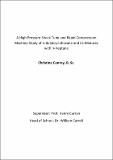| dc.description.abstract | This study presents a high pressure experimental and modelling investigation on the ignition of n-butylcyclohexane and its mixtures with n-heptane. Mixtures were chosen to represent a surrogate for n-decylcyclohexane, a constituent of transportation fuels which has an extremely low vapour pressure and hence it is currently impossible to carry out gas phase experiments using this fuel. Thus, mixtures of 53% n-butylcyclohexane and 47% n-heptane were prepared and studied to mimic the same hydrogen/carbon ratio as n-decylcyclohexane.
Ignition delay times were measured in two heated shock tubes in the temperature range 800 - 1550 K, at reflected shock 1, 10, 30 and 50 atm and at equivalence ratios of 0.3, 0.5, 1.0 and 2.0 in air for both n-butylcyclohexane and mixtures of n-butylcyclohexane / n-heptane.
The shock tubes used in this study consists of a 3 m driver section and 5.73 m driven section separated by a double diaphragm section. Upon rupture of the diaphragm a shock wave is generated. This shock wave moves into the driven section compressing and heating the test gas. The ignition delay time is defined as the time from the arrival of the shock wave at the end wall to the ignition of the fuel. Ignition delay times were measured from 50 µs to 3 ms.
Ignition delay times were also measured in a heated rapid compression machine in the
temperature range 580 - 800 K, at compressed gas pressures of 10 and 30 atm for both n-butylcyclohexane and mixtures of n-butylcyclohexane / n-heptane at the equivalence ratios outlined for the shock tube.
The rapid compression machine used in this study is a twin opposed system capable of
compression of test gas mixtures up to 60 atm with a compression time of approximately 16 ms. Ignition delay times were measured from 3 ms to 100 ms.
Due to the low vapour pressures of the fuels used in this study homogeneous heating of the equipment was essential to ensure that the fuel remained in the gas phase. Heating systems were installed onto the shock tubes and rapid compression machine, mixing tanks and manifolds.
Experimental results obtained for both n-butylcyclohexane and mixtures of n-butylcyclohexane / n-heptane were compared to simulations of two models which are available in the literature, JetSurF 2.0 and Natelson et al.. The models failed to capture the experimental data.
In addition ignition delay times are also measured in the low pressure shock tube. This is a stainless steel shock tube with a 6.22 m driven section and a barrel shaped driver section. This is a single diaphragm shock tube. During an experiment the diaphragm is ruptured by a cross shaped cutter housed inside the driven section of the shock tube. Increased drive gas pressure caused the diaphragm to bulge and come in contact with the cutter resulting in the bursting of the diaphragm. Ignition delay time is defined as the time from the arrival of shock wave at the end wall to the maximum rise in CH* emission. Ignition delay times were measured from 50 µs to 1000 µs.
Ignition delay times of the isomers of pentene were measured in the low-pressure shock tube. Experiments were carried out using 1- and 2-pentene in the temperature range 1250 - 1900 K, at a reflected shock pressure of 1 atm and at equivalence ratios of 0.5, 1.0 and 2.0 at 1% fuel concentration. Experimental results were used to validate the model of Mehl et al. This work was presented at the 33rd Internal Symposium on Combustion.
Ignition delay times were also measured for 2,5-dimethylfuran in the low pressure shock tube. Experiments were carried out in the temperature range 1300 - 2000 K, at a reflected shock pressure of 1 and 2 atm and at equivalence ratios of 0.5, 1.0 and 2.0 at 0.75% fuel concentration. This works builds upon a study previously carried out by G. Black at NUI Galway where low pressure shock tube ignition delay times were measured at 1 atm, phi = 1.0 and 2.5. Experimental results from this study were used for model validation. Ignition delay times were also measured for 2,5-dimethylfuran in the low pressure shock tube. Experiments were carried out in the temperature range 1300 - 2000 K, at a reflected shock pressure of 1 and 2 atm and at equivalence ratios of 0.5, 1.0 and 2.0 at 0.75% fuel concentration. This works builds upon a study previously
carried out by G. Black at NUI Galway where low pressure shock tube ignition delay times were measured at 1 atm, phi = 1.0 and 2.5. Experimental results from this study were used for model validation. | en_US |


